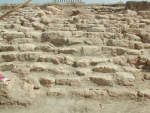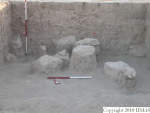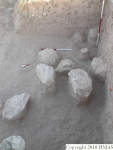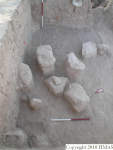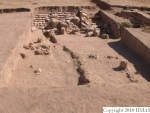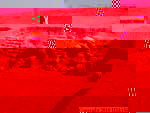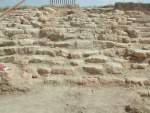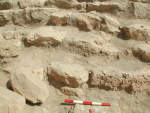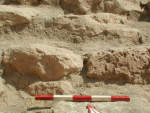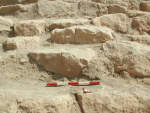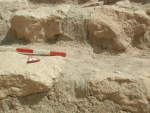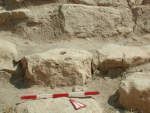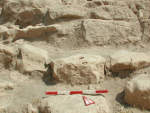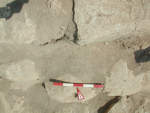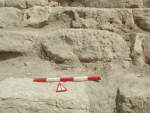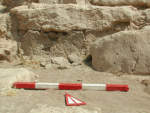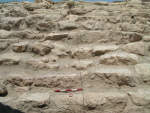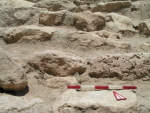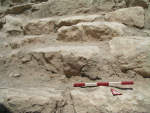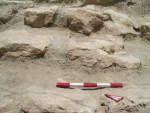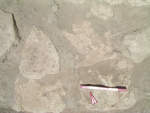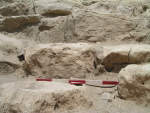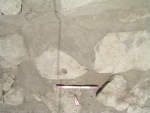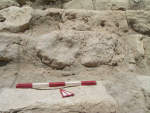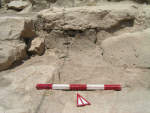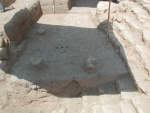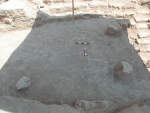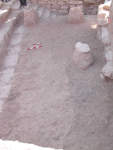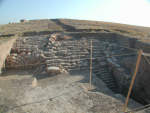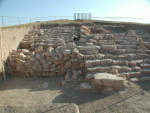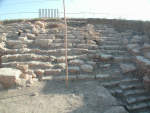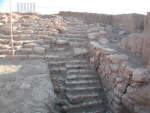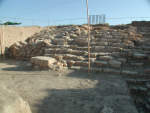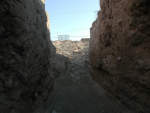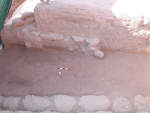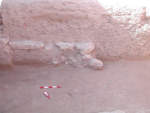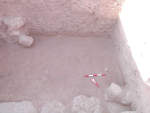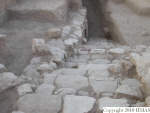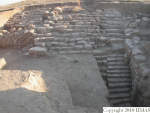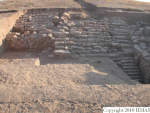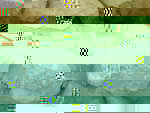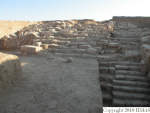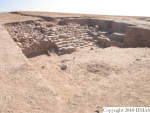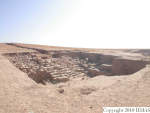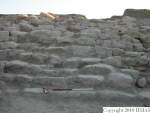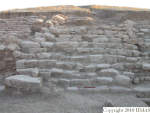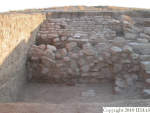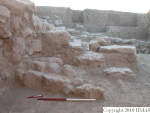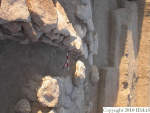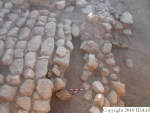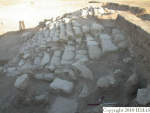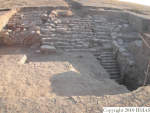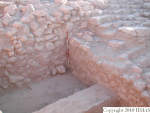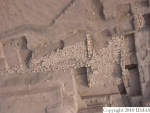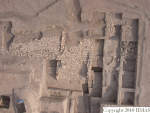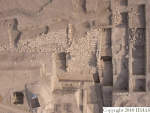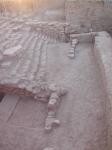1. OVERVIEW
| Roster | Date | Author | Record |
|---|---|---|---|
| Best image | 2014-10-24 | cJC |  [Input: YX24CJC.j] [Input: YX24CJC.j] |
2. IDENTIFICATION
Designation
| Roster | Date | Author | Record |
|---|---|---|---|
| Description (summary) | 2004-07-01 | mh | North of k4, west of k100. A German trench cuts through its souther half in east-west direction. Defined by the markers m3589, m3597, m3646, m3647, m3599, m3648 [Input: O703MH2.j] |
| 2008-03-07 | pC | k 3 is a regular locus south of k2. The upper part is cut by the german trench. It was opened to see the continuation of the apron f131 [Input: S206PC.j] |
3. STRATIGRAPHY
Recovery/Assignment
| Roster | Date | Author | Record |
|---|---|---|---|
| Daily notes about recovery of elements | 2004-07-01 | mh | Opened the square and had time to remove just the upper most surface layer in the northern half of the square. [Input: O703MH3.j] |
| 2004-07-04 | mh | In the morning we continued removing topsoil in the northern half of the unit. Near the eastern baulk of the unit we found a nearly complete skeleton of a small juvenile canine. I assigned that as i2. [Input: O704MH.j] | |
| 2004-07-05 | mh | Continued down on the northern half. 3cm before the end of f29 q53 we ran into a slightly harder batch of soil in the NE corner of the unit. It's aerial extent was m3647 50W, 50S. I did not make it into a separate feature since it did not substantially differ from what was around it. Here the softer parts were just slightly further apart than elsewhere. [Input: O705MH4.j] | |
| 2004-07-06 | mH | We continued going down with f25, natural soil matrix. At the interchange of q62 and q66 we found several large stones. These stones are located 9 cm higher than the southern most stones in the German trench to the north of k3. While this difference is not much, the stones are clearly higher up than I expected to find stones associated with the apron. From the German trench it seems that the apron is sloping down and hence stones belonging to the apron should be deeper in k3 than in the German trench. It is possible that stones visible in the German trench are not the original top most stones and that the stones in k3 are. Another possibility is that the stones in k3 are eroded stones. I doubt that, however, since there are quite a few of them and they sit quite densely together. [Input: O706MH.j] | |
| 2004-07-07 | aP | we are going on with the digging of the northern part of the square where we found stones of medium-big sizes clearly collapsed from the north (maybe from the apron). The soil is soft and with fair pottery. Today we dug f32 q71, q79, q81 and q85. [Input: O707AP.j] | |
| 2004-07-08 | ap | we levelled the excavation surface (f32, q90) cleaning between the stones and starting to relay the points of the collapsed material. To distinguish these stones from the other material we decide to make a new feature (f45) which sits in f32. [Input: O708AP.j] | |
| 2004-07-11 | aP | after two very windy days (7/09-7/10) we spent some time cleaning the surface of k3 to take picture of the loose stones. After we took the relays for most of them but for four were not possible since the positions of the item didn't allow to take points. So we need to put some new markers after removing baulks. [Input: O711AP.j] | |
| 2004-07-24 | aP | we went on, continuing to remove the eastern baulk of k3 (f92, q243), and removing the columns of soils on which the eroded stones were placed (f90, q241). [Input: O725AP1.j] | |
| 2004-07-24 | mh | We continued removing the eastern baulk of the unit. After it was removed, we continued to level and clean the unit. [Input: O730MH.j] | |
| 2004-07-25 | ap | at the moment this is the most interesting square for the stratigraphic connections. We started going down in the southern part of the square, south to the stones (f32, q249) but about 20 cm down (m3882 + 62 - 153) we noticed two different features: f97 (q258, q260) is in the eastern part of the square. The soil is not particularly compact, brownish/reddish with large amount of sherds and pebbles of small and medium size. In the western part of the southern half of the square instead we noticed a different kind of soil (f98, q259). Here the soil is rather hard with a large amount of very compact gravels and few sherds. The texture is quite similar to the soil which was found last year in J1 but here it's limited at one lens. In the northern part of the square we also removed the columns of soil under the eroded stones collecting some sherds (f90, q262). [Input: O726AP.j] | |
| 2004-07-26 | aP | scraping the surface we notice two different features which are at the same level. In the north-western corner we found a layer (f99, q267) with soft ashy soil and few sherds. I defined it a lens since it seems concentrated just in the north-western corner. In the eastern part of the area, instead, we found reddish soil (f101, q268) quite compact and with a large amount of sherds. This layer is below the layer that we dug yesterday (f97) with large amount of sherds and small pebbles and above the melting bricks which are visible in the east section (western side of the German trench). At a first sight it seems to me that the are many Khabur sherds, maybe we can ask mkB to analyze the pottery bag. Below this layer we found in all the area (now approximately 4m wide and 1m length) a layer which contains melting bricks. This new feature (f106, q273, q282 and q285) is composed by melting bricks mixed with pottery. The colour of the soil is reddish, the same colour of the core of the bricks which, instead, are grey. [Input: O728AP.j] | |
| 2004-07-27 | aP | we started going down with the excavation of the layer with melted bricks (f106, q289 and q298), cleaning some other stones which became visible. Below this layer we reached the brickfall, already recognized in section. f112 is composed by bricks (some complete and some broken) which are gray on the external surface and have a red core (f112, q279 and q304). [Input: O730AP.j] | |
| 2005-08-02 | mH | We have very little of the original loci left to excavate because stones of apron f131 now occupy most of the unit in its northern and middle areas. There is no baulk between k3 and k4, which makes it difficult to tell where the one ends and the other begins. This situation will improve once bP re-establishes the baulks of these loci. Today we defined our features and q lots so that when we removed the first 10 cm of the surface (contamined soil), we defined it as f136. Underneath we established f139 but defined it as beloging to k4 although in actuality it extends little bit over to k3. [Input: P802MH.j] | |
| 2005-08-03 | mH | There is only very little left of this square as most of is occupied by the stones of the first apron f131. As yesterday we did not assign separate feature numbers for this loci but used the ones of k4 as it is difficult to tell where the one ends and the other beginings. The q lot that partly refers to this loci is f139 q372 when we removed approximately 10 cm soil in the western half of the joint k3 and k4. The next is f139 q375 which partly refers to the eastern half of k3 and k4. The latest q-lot, f141 q380. This latter pick run exposed more steps of the apron. [Input: P803MH.j] | |
| 2005-08-04 | mH | We had discovered laminations (f141) approximately in the middle of the loci the day before and excavated some of those laminations. Some of them, however, still remained today. We had also differentiated the material north of the laminations as f145. This feature did not contain laminations, but is similar to the material above them and what we have generally been finding in this loci. We decided to remove 10cm of this feature with a big pick (q381) in order to examine the border of the two features and see whether the laminations would still continue. The border of the two features indicated that the laminations only continued for a layer or two. Since we did not see it necessary to keep following the laminations and because our goal in this loci is to reach the steps of the 1st apron (f131) below, we decided to remove the remaining of the laminations (q383). Once the laminations had been examined the SE corner of the unit that we had defined as f143 because it contained charcoal and more pottery than the laminations (f141) abutting in the north. f143 was also much softer than the lamination (f141) layer. We had originally thought that that this feature could be pit, but after excavating it (q385), we determined that it was not a pit, but just another type of accumulation. After removing the laminations and determining that the feature in the corner was not a pit, we removed a circa 50 cm stretch of soil (q386) in order to expose another step of the apron (f131). [Input: P806MH.j] | |
| Strategy (projected or implemented) | 2004-07-04 | mh | We will continue going down with big picks. [Input: O704MH.j] |
| 2004-07-06 | mH | Tomorrow we will continue down around the stones. I will changed the feature number for the soil around them. [Input: O706MH.j] |
Volumetric Localization
| Roster | Date | Author | Record |
|---|---|---|---|
| Elements within locus | 2007-07-18 | pC | a7 (structure) [Input: S206PC2.j] |
| 2004-07-04 | mh | f18 (topsoil) [Input: O807AP4.j] | |
| 2004-07-04 | mH | f25 (layer) [Input: O807AP5.j] | |
| 2004-07-07 | mH | f32 (lens type d) [Input: O807AP5.j] | |
| 2008-01-31 | pC | f45 (isolated stone) [Input: S131PC3.j] | |
| 2010-08-10 | yM | f90 (lens type d) [Input: U0810YM.j] | |
| 2004-07-24 | ap | f92 (lens type d) [Input: O808AP3.j] | |
| 2004-07-25 | ap | f97 (lens type d) f98 (accumulation D) [Input: O808AP3.j] |
|
| 2004-07-26 | ap | f99 (layer) f101 (accumulation D) f106 (lens type d) f108 (lens type d) [Input: O808AP3.j] |
|
| 2004-07-27 | ap | f112 (brickfall) [Input: O808AP3.j] | |
| 2004-07-31 | ap | f131 (apron) [Input: O808AP3.j] | |
| 2005-08-02 | sC | f136 (accumulation D) [Input: P803AL2.j] | |
| 2005-08-07 | sC | f154 (isolated stone) [Input: P912MH.j] | |
| 2010-09-05 | yM | i5 (seal impression) [Input: U906YM.j] | |
| 2004-07-01 | mh | q40 (pottery) [Input: O703MH.j] | |
| 2004-07-04 | mh | q49 (bones, pottery) q52 (pottery) [Input: O705MH2.j] |
|
| 2004-07-05 | mh | q54 (items, pottery) q59 (pottery) [Input: O705MH2.j] |
|
| 2004-07-06 | mH | q62 (items, pottery) q66 (items, pottery) [Input: O706MH2.j] |
|
| 2004-07-07 | ap | q71 (pottery) q79 (pottery) q81 (pottery) q85 (pottery) [Input: O710MH.j] |
|
| 2004-07-08 | ap | q90 (items, pottery) [Input: O710MH.j] | |
| 2004-07-21 | ap | q220 (bones, pottery) [Input: O721AP2.j] | |
| 2004-07-22 | mh | q226 (pottery) q240 (pottery) [Input: O724MH.j] |
|
| 2004-07-24 | ap | q241 (pottery) q243 (items, pottery) [Input: O724MH.j] |
|
| 2004-07-25 | mH | q249 (bones, pottery) q258 (bones, pottery) q259 (pottery) q260 (bones, pottery) q262 (pottery) [Input: O726AP1.j] |
|
| 2004-07-24 | mH | q267 (pottery) q268 (bones, pottery) q273 (pottery) q280 (bones, pottery) q282 (pottery) q285 (bones, pottery) q289 (pottery) q298 (bones, pottery) q299 (pottery) q304 (pottery) [Input: O726AP1.j] |
|
| 2005-08-03 | vvE | q364 (bones, items, pottery) [Input: P803AL3.j] | |
| Extension of locus or q-lot | 2004-07-01 | mh | m3646 [Input: O703MH2.j] |
| Length of two sides | 2004-07-01 | mh | 400e [Input: O703MH2.j] |
| 2004-07-01 | mh | 400s [Input: O703MH2.j] |
